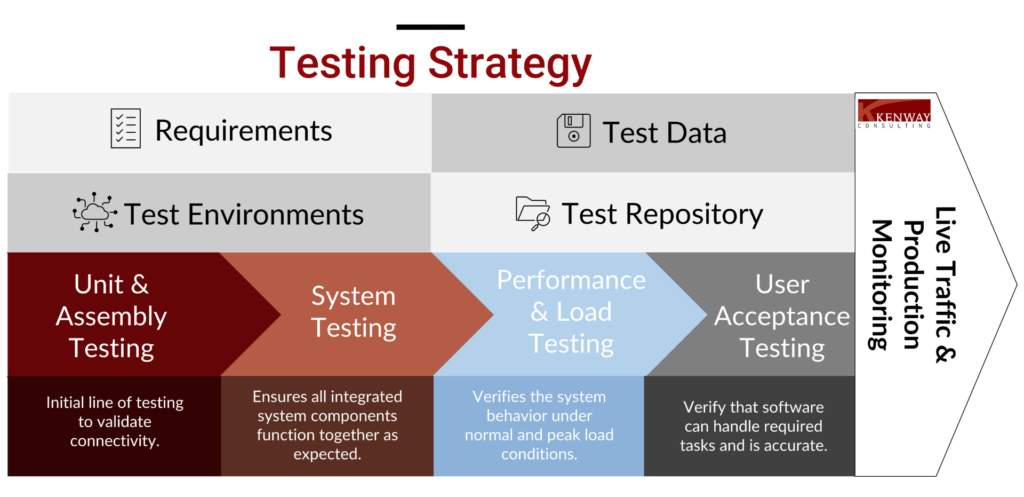Building Your Organization’s Testing Strategy

A test strategy is an essential component of an organization’s software development approach and outlines the overall process and objectives for product testing. It acts as a blueprint defining the scope and resources required, the testing tools to be employed, the risks involved, and the schedule for testing activities.
A well-crafted test strategy not only ensures a comprehensive evaluation of the product’s functionality, reliability, and performance but also helps identify defects at an early stage. Finding defects early saves time, reduces costs, and contributes to the final product’s overall quality by reducing churn in the development cycle and leads to fewer defects pushed to production. Quality Assurance testing is not only about defining the types of testing and methodologies (e.g., automated or manual) but also about setting clear expectations, fostering early and continuous engagement, and thereby promoting a quality-focused, efficient development process.
The Impact of Delivery Methodologies
An organization’s approach to testing will depend on their delivery methodology, be it Waterfall or Agile. The choice of methodology directly impacts the testing strategy, timeline, resource allocation, and the tools and techniques employed.
The Waterfall model is a linear, sequential approach to software development, where progress flows steadily downwards, like a waterfall, through conception, initiation, analysis, design, construction, testing, deployment, and maintenance. Given its structured and sequential nature, testing in the Waterfall model occurs late in the lifecycle – after the ‘construction’ or ‘development’ phase. This implies that any bugs or issues discovered during the testing phase can lead to increased costs and time delays, as changes might require revisiting and modifying large sections of the code.
Conversely, the Agile methodology is iterative and incremental. Testing in an Agile model is continuous and integrated into the development process, often performed in every iteration or sprint. This continuous testing approach enables teams to identify and address issues promptly, enhancing software quality, and reducing time to market. Agile’s dynamic nature, however, means that the testing team needs to adapt quickly to changing requirements and maintain robust communication with the developers and stakeholders.
Types of Testing
There are several types of testing that should be carried out to ensure the quality and performance of the product. Understanding these tests and defining their place within the testing strategy allows teams to ensure that their testing efforts provide the desired level of coverage.
- Unit Testing is the first line of defense where individual components of a software are tested generally by developers. The objective is to isolate each part and verify its correct operation.
- System Integration Testing (SIT) involves testing the interaction between different software modules to identify interface issues. SIT ensures that all integrated system components function together as expected.
- Assembly Testing is a subset of SIT focused on ensuring that the assembled components work together as expected, checking the data communication among modules.
- Performance Testing measures the software applications’ speed, scalability, and stability under a workload.
- Load Testing verifies the system behavior under normal and peak load conditions. It helps to identify the maximum operating capacity of an application and any bottlenecks that can interfere with its performance.
- Regression Testing is conducted after modifications or updates in the software to ensure that existing functionalities continue to work as originally designed. The intent is to catch bugs that may have been accidentally introduced during new code implementations or due to previous fixes.
- Usability Testing evaluates how user-friendly and efficient the software is for the end users by monitoring their interactions with the solution.
- User Acceptance Testing (UAT) is the final phase of testing, where the software is tested in the real-world scenario by the intended audience. The goal is to verify whether the software can handle required tasks in user conditions and is accurate.
Each of these tests plays a vital role in the software development process and must be accurately defined in the testing strategy. The testing strategy should lay out when and how each test type will be conducted, the owner of each test, the resources and environments required, and the objectives of each test. The right balance and sequence of these tests within the testing strategy ensures that software is efficient, effective, user-friendly, and robust under varying conditions.
Requirements Traceability, Dependency Mapping, and Value Stream Mapping
Requirements Traceability, Dependency Mappings, and Value Stream Mapping are fundamental to ensuring requirements are met, enhancements do not disrupt existing functionality, and improvements can be properly prioritized based on ROI and impact. Organizations must set expectations and define processes to create and maintain these deliverables as part of their overarching test strategy to maximize their benefit.
- Requirements Traceability is a process used to track work items throughout the development life cycle. It connects the origins of the requirement to its final implementation, traversing through the development stages. A Requirements Traceability Matrix allows a QA (quality assurance) team to write appropriate test scenarios from the original requirements to ensure all requirements are fulfilled in the final product and that no superfluous functions were added. It is pivotal in managing changes, as any alterations in the requirements can be seamlessly transitioned across all stages, minimizing the risk of overlooking impacted sectors.
- Dependency Mappings deal with the interconnections between various software modules. Understanding these dependencies is essential as alterations in one module may affect others. Having a clear map of these dependencies helps predict the potential impact of a change, enabling change management, and preventing unforeseen issues later. It also supports accurate regression testing by identifying which parts of the software may be affected by a code change.
- Value Stream Mapping is a lean-management method for visualizing the necessary steps from product design to product delivery. For a testing strategy, it becomes crucial in identifying wasteful processes in the testing lifecycle and finding opportunities for streamlining or automating tasks. It helps identify bottlenecks, repetition, and delays in the testing process.
These processes are critical to improve visibility and control over the software development process. Coupled together they contribute to a well-defined testing strategy, ensuring comprehensive coverage of all requirements and dependencies resulting in a reliable, high-quality, software product.
Test Repository
Creating a structured process for developing and maintaining a Test Repository is crucial for effective test management. A Test Repository serves as the centralized location for all test artifacts, including test cases, test scripts, test data, and testing results. This centralization ensures easy access, enhances reusability, and promotes consistency across the testing lifecycle.
A high-quality Test Repository must have the following components:
- Well-documented and easy-to-understand test cases and scripts that reflect the business requirements.
- An organized set of test data, which can be used across different testing stages and allows for repeatable and consistent test executions.
- Testing results, including insights on testing coverage, defects discovered, their resolution status, and the impacts on the software quality.
- Established naming conventions enabling searchability, reducing the risk of duplication, and allowing existing tests to be easily updated when enhancements are introduced.
This systematic process for managing a Test Repository ensures traceability, facilitates knowledge sharing, and promotes communication among team members. It serves as a significant asset for regression testing and future projects, saving time and effort in the long run.
Test Data
Test data plays a vital role in determining the outcome of a software testing process. A well-defined test strategy will drive the use of quality data and yield better testing outcomes. It will provide a detailed plan on when and where to use different types of test data, ensuring the right conditions are established for each testing stage. By emphasizing schema compliance and persona-based testing, the strategy promotes comprehensive and realistic testing, enhancing the likelihood of identifying potential defects and improving the overall quality of the software.
Schema compliance is vital for all types of test data. It ensures that the test data adheres to the established rules of data organization within the system, thus guaranteeing data integrity and reducing the risk of invalid test results.
Persona-based testing is an approach where user personas are created to represent different user types that might interact with a product. Persona-based test data should be developed based on these personas’ behaviors and needs, ensuring a wide range of scenarios are tested that cover the potential uses of the application.
Based on the function and the testing stage in which it is used, test data is categorized into three types.
- Stubbed data is created specifically for testing certain functionality. It helps to isolate the system component being tested and supports the creation of controlled test conditions. For example, it can be used when the system component being tested doesn’t rely on the data from other components or when the data from other components is hard to acquire.
- End-to-end data, as the name suggests, is used in end-to-end testing. This is a comprehensive testing process where the data flow among all components of the system is tested from start to finish, ensuring all the integrated pieces of an application function are as expected. The data used should mimic real-world usage and interactions to evaluate the system’s functionality under realistic conditions.
- Hybrid data is a mix of stubbed and end-to-end data. This type of data is often used when certain parts of the system need to be isolated (using stubbed data), while the remaining parts of the system require end-to-end data to emulate realistic conditions.
Test Environments
Within a comprehensive testing strategy test environment management serves as the linchpin that bridges software development with practical validation. Its importance lies in its ability to mirror real-world conditions, simulating diverse user scenarios and uncovering critical issues before deployment.
To fully realize the potential of effective environment management your organization must align release cycles and branching strategies while ensuring compliant configurations and environment stability. This ensures that configurations remain in lockstep with project objectives and comply rigorously with the intricacies of each release. A harmonious integration of test environments within the broader testing landscape not only accelerates issue detection but also fosters a systematic and reliable approach to quality assurance, safeguarding the software’s integrity while enhancing overall user satisfaction.
A Well-Defined Testing Strategy
A well-defined testing strategy is instrumental in fostering a “pivot left” approach, where testing and quality control are incorporated early in the software development lifecycle. This proactive approach focuses on preventing defects rather than merely detecting them later. Teams can drastically reduce the cost and time involved in the development process, leading to more efficient project execution and higher product quality.
In this context, the testing strategy should clearly define the “done” criteria for development. Such criteria may include specific requirements like code quality standards, successful execution of unit tests, or completion of documentation. A clear understanding of when development is considered “done” aligns the entire team’s expectations and contributes to a more streamlined process.
An effective testing strategy emphasizes stakeholder engagement. Requirements and artifacts should be thoroughly reviewed and agreed upon by all stakeholders prior to the build phase. This is essential to avoid any misunderstanding or miscommunication that could lead to delays or rework. Additionally, during and after development, demos should be conducted to engage stakeholders, provide them with a clear understanding of the product’s progress, and gather feedback. This will ensure that the product is developed according to stakeholder expectations and any potential issues or changes are promptly addressed.
How Kenway Defines and Implements Testing Strategies
At Kenway Consulting we help our clients define and implement robust test strategies tailored to their unique requirements. Our consultants bring decades of expertise to construct an approach that aligns with the organization’s goals, existing infrastructure, and project timeline. We ensure that the strategy is executable within the client’s organization and provide necessary training, resources, and ongoing support to ensure the strategy’s seamless integration, thereby optimizing software development processes and ensuring the delivery of high-quality products.
If you need help tailoring or implementing all these components into your test strategy or driving a quicker and more effective software development process connect with us at info@kenwayconsulting.com. We’re here to help.









